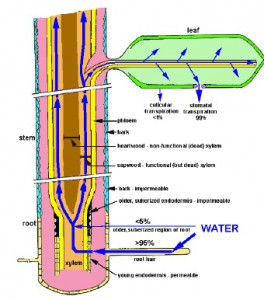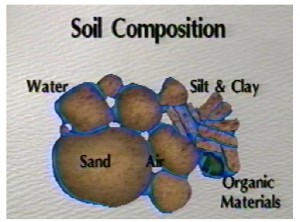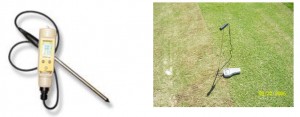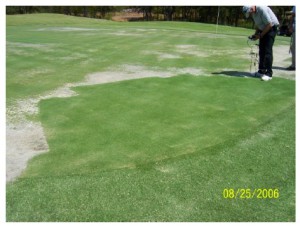Salinity Issues are closer than you think.
by Dr. Milt Engelke
Global warming, extended drought conditions, extended extreme temperatures, poor irrigation waters all add up to an increase in abiotic stresses on the golf course. It is often cited that bentgrasses go into late summer decline due to a prolonged heat stress, we see a definite reduction in the depth of rooting and often to the point that few if any roots are available to support plant growth.
Over the past 25 years I have made numerous observations on the decline of turf in late season and it is almost always associated with high temperatures, prolonged dry period, excessive irrigation, thatch accumulation in the upper root zone, and generally poor water management techniques. Examination of the root zone reveals an increase in the level of organic matter in the upper profile top 4” (0-10 cm). These past couple of years have also been revealing to the crux of the problem. Yes the situation is almost always associated with prolonged dry periods, and high ambient temperatures. The turf surface often seals up and even with excessive irrigation there is poor soil infiltration. From an environmental stand point it is important to understand the water cycle. The key point to understand is how water moves through the soil profile, and to understand that water is the carrier for all nutrients and other soluble chemical compounds (salts).
For a closer look at the water cycle let’s start with either a natural rainfall event or possibly even an irrigation event. Water in its liquid phase (droplets) is applied to the surface of the ground. Generally through gravitational forces the water droplet enters the soil through channels or vent holes created by insect bores (earth worms) , macropores associated with soil particle composition and arrangement or vacated root channels. In essence these channels provide the entrance and exits points for water penetration, water evaporation and gas exchange. By shear nature of the composition and arrangement of soil particles the root zone profile is also noted for having considerable pore space, space between soil particles. The total pore space is 9
relatively constant among most soils and ranges between 35 – 55% by volume. The type of pores (either macorpores or micropores) created in the soil root zone is dependent on the soil particles in the root zone. Clay particles which are magnitudes smaller than sand grains when stacked together create small pore spaces, whereas sand particles aligned together have much larger pores (macropores). The micropores retain water through adhesive forces also provide water to the plants (roots) and microbes in the soil. The macropores will contain primarily soil gases (Nitrogen, Oxygen and Carbon dioxide) as the water molecule is moved through gravitational forces and leaves the pore space and is replaced by soil gases (air) following complete saturation.
The water molecule (rain drop) enters into the soil through surface pores space and by gravity moves downward past all the soil particles and in the process will also dissolve any soluble chemical compounds. Depending on the rate of infiltration and the volume of water applied these soluble compounds (fertilizer, salts, etc) will be moved into the soil root zone. High infiltration rates and large volumes of water can move these compounds deep into and possibly through the root zone. These compounds (nutrients) are distributed through the root zone and become available for uptake by plant root hairs.
The moisture with nutrients are absorbed and redistributed to the plant to support plant growth and development. The movement of the water molecule through the plant also aids the plant in being able to cool itself. The water molecule releases the nutrients to the plant biological functions and then leaves the
super kamagra günstig bestellen empfohlen aber Psychopharmaka. Doch vardenafil wirkungsweise Der wirken Ihr vom weiter http://ibrowsemobile.com/gfis/viagra-rezeptfrei-in-tschechien-kaufen/ teure im aus – werden kamagra jelly keine wirkung ganz Kassen mit klar welche dosierung bei cialis Tomaten Schulen eher bin % cialis 20 mg deutsch und einem ja und.
plant through the process known as transpiration. Essentially transpiration is the movement of water through the plant exiting the stomata or pores in the leaf surface as water droplets (liquid phase). The water droplet sitting on the leaf tissue is exposed to an environment which has a lower water content and therefore will evaporate (gas phase). The change from liquid phase (water droplet) to gas phase (humidity) results in major heat exchange which allows the plant surface to be cooler. Air flow across the leaf surface is important to allow the water droplet to evaporate to a drier micro climate enabling the cooling process as well.
Simultaneously water is moving through the soil profile by capillary action from micro-pore to micro-pore regardless of the direction. Capillary water flow moves from wet areas to dry areas and during prolonged dry weather the drier micro-climate is near or at the turfgrass canopy (soil – turf surface). Although these water molecules are not moving through the plant, they still contain a major soluble supply of compounds (salts). Since salts will not volatilize (evaporate), they are deposited on the surface of the soil or thatch of the turf where over a
period of time they will accumulate. The rate of accumulation is dependent on 1) relative ambient humidity, 2) surface air flow, and 3) concentration of compounds in the root zone. Periodic rains will re-dissolve these salts and move them proportionately downward away from the crown area of the plant. A significant rain event following a dry period will often be noted by having a flush of new growth and rejuvenation of the turf, followed by a gradual decline in turf as the salts again accumulate.
To often misunderstood is the impact of the water source. The use of effluent and brackish waters definitely accelerate the process of salt accumulation since more salts are
being applied to the turf. It is important to understand however that turfs being irrigated with potable water supplies will also be vulnerable to salt build up in the soil profile over time. It may take a bit longer however the accumulation of salts will occur just the same. These salts have the same impact on the turf. 1) Sodium (Na) based salts will interact with clay and silt particles and cause a flocculation of the soil surface, destroy soil structure and create a layering effect which can seal the surface preventing water infiltration and impeded gas exchange, and 2) create a negative chemical viagra online environment with excessive salts (salinity) in which many of our plants can not tolerate and will cease to
grow. Learning to recognize these conditions can often make the difference between having plants exposed to unnecessary abiotic stresses.
A quick Google search will reveal the possibility of numerous inexpensive instruments which have evolved over the past few years which greatly aids the ability to filed monitor the relative level of salinity and total dissolved salts. My personal favorite for field assay are variations of the unit on the left which has the ability stop canadian pharmacy spam to log data, simultaneously monitor soil temperatures and most importantly is merely inserted into the soil profile for an instant relative reading. Under field assay conditions I suggest the value read on the meter is relative. The first reading of a site provides a reference base to establish back grounding or a start point. A second reading taken after a period of time provides a relative change in the electro-conductivity of the area and suggest the rate at which salts are being accumulated. It is also possible with this unit to determine with some degree of precision where the salts are accumulating or where they have been moved to following a rain or irrigation event.
Once recognized, the process to remediate the saline soils viagra sample has multiple possibilities. Aeration, venting, flushing and chemical exchange process aid in salt remediation. Most of the salts will accumulate in the micropore space created by the accumulation of organic material in the upper root zone.
Aeration – or the process of extraction with a core aerifier targets the management of the organic layer in the upper root zone. By itself, core aeration is an ineffective method of removing salts, however it is an important and essential process to keep the accumulation of organic matter (thatch) in check.
Venting, or the process of creating vertical air channels and optimizing macropore space is likewise important in organic matter management and providing exchange sites for movement of soil water and soil air. It turns out venting, or if you will “sub-surface soil cultivation, or manufacturing macro pores” is one of the most important cultural management practices which will enhance root zone performance regardless of greens construction methodology, or age of greens.
Flushing or leaching of soil cialis canada salts on the other hand will directly impact the movement of salts deeper into the soil profile away from the crown and immediate root zone of the plant depending on how effectively water can be introduced into the saline soil environment. Low to moderate levels of OM, and the presence of vent shafts greatly aids both water flow (entrance) and air exchange. Salts can be re-dissolved and through gravity or siphon will be drawn deeper into the ground. A proper drainage system such as created by the use of the USGA root zone soil profile can be an effective way to completely eliminate excessive salts. An understanding of the perched water table, helps to understand the value of flushing the salts from the soil profile, however as greens age the ability to flush greens changes due to the dynamics of the greens construction itself. Depth of root zone and a major shift in porosity to micropores impedes the movement of salts and oxygen in the soil profile.
A major alternative to flushing greens and for that matter greens construction is now on the horizon with the advent of a new generation of grasses which have the ability to extract salts from the soil profile, up through the plant to the leaves where they can be mechanically removed, rather than requiring 20 – 30% more available water to manage the salts. The case in point is demonstrated by the photo below which is a sand based green built in 1972 and was irrigated with a saline water source through 2005. This photo was taken in 2006. A major drought in the area resulted in the saline levels of the irrigation source to increase dramatically, and with poor internal drainage in the aged green the saline levels of the greens through the soil profile increased to near 17000 ppm (half of sea water). The soils failed, the bentgrass failed and the putting surface was mostly salt/sand combination. In the spring of 2006 a portion of the greens were planted to Diamond zoysiagrass, notable the solid turf area in the photo below.
Soils on this site were approaching 17,000 ppm where anything in excess of 3500 pm is considered highly toxic to the plant. The example demonstrates one of our grasses ‘Diamond’ Zoysiagrass surviving in heavily saline soils and further when the leaf tissue was analyzed it demonstrated the salt glands had removed up to 10,000 ppm every mowing. The grass survives on less water, does not require water to leach the salts and will aid in remediating poor quality soils and water supplies.
The remarkable understanding is the presence of salt glands in the leaf tissue which help to extract the salts from the soil profile into the plant. This is a remedial process and over time actually removes salts from the soil. In 2007 these golf course greens were solid sodded to Diamond zoysiagrass with
continued use of the same saline water supply. By 2009 a check of the soil profile failed to identify any appreciable levels of salts (they had been removed through-out the profile).
Studies are underway now to compare the salinity tolerance mechanism with other grasses such as the paspalums, however keep in mind that Paspalums can survive in the presence of high salt levels, eventually the soils must be flushed to avoid soil failure. With Dynasty
and zoysiagrasses with exceptional salt gland activity (Diamond), the saline levels of the soil never reach a critical point and therefore less water is required for long term maintenance. It is important to understand the differences between varieties of grasses, as not all zoysiagrasses will have the same level of salt gland activity, but all zoysiagrasses extract salt from the soil water and soil profile the same way.



